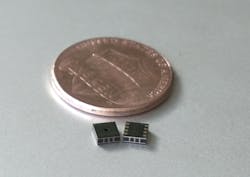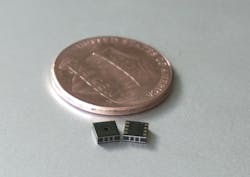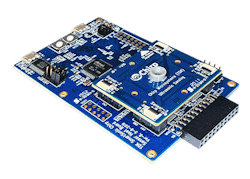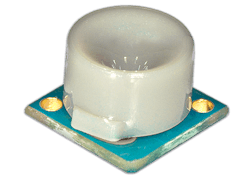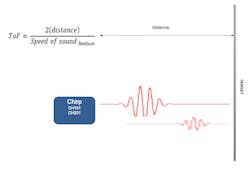ToF Ultrasonic MEMS Sensors Unlock the Door to Proximity and Presence Sensing
Time-of-flight (ToF) sensors open up new application areas and use cases for proximity sensing and presence detection technologies, and these sensors can add valuable functionalities and intelligence to smart home applications, such as smart door locks.
A new generation of miniaturized ultrasonic time-of-flight (ToF) sensors enable new application areas and use cases for proximity sensing and presence-detection technologies. These sensors can add valuable functionalities and intelligence to smart home applications, such as smart door locks.
Smart home trends
According to a recent GMI Research report, the global smart homes market is forecast to grow at a CAGR of 11.6% from 2019 to 2027, by which time, projected generated revenues could reach US $166 billion. However, current sensing technologies used to date, such as passive infrared (PIR) sensors, infrared (IR) proximity sensors, radar, and camera vision, are reaching their technical limits.
Similarly, IR proximity and IR ToF sensors consume high levels of power. They have a very narrow FoV and lighting and targeting limitations. Radar technology requires a lot of energy to operate, and the end-system design is complex, bulky and costly. Camera vision is expensive too, and, because it is processing-intensive, energy consumption is high, and there are privacy concerns to consider.
Ultrasonic MEMS-based sensors
Discrete piezoelectric transducer-based sensors overcome most of these challenges. They work using ultrasound to build a dynamic picture of the surrounding environment. The ultrasonic pulse reflects off an object and creates an echo pulse back to the sensor. The ToF is the roundtrip time it takes for the pulse to be sent and the echo to be received, which is used to determine the distance of the object from the sensor.
Several features allow for low power operation. The host processor does not need to make any ToF calculations nor does it need to provide any stimulus to the sensor during normal operation. The sensor’s ASIC can run firmware algorithms allowing the host processor to shut down into its lowest power mode until the sensor generates a wake-up interrupt when motion is detected.
Depending on product choice, range finding is up to 5m for the CH201 and 1.2m for the CH101. They both have the same 3.5 mm x 3.5 mm hardware footprint, ASIC and pin-out. They work in any lighting condition, including full sunlight or complete darkness, and provide millimeter-accurate range measurements independent of the target’s color and optical transparency.
Chirp has several small form factor ultrasonic modules with varying fields of views to accelerate evaluation and development of these revolutionary sensors into small product enclosures. The turnkey ready-to-use firmware, which is loaded onto the ASIC, turns the ultrasonic echo data into information that enables many use-case scenarios, including range-finding, presence and proximity sensing, object-detection and avoidance, position-tracking and even floor-type identification in robotic vacuums.
Smart locks
Advances in biometric fingerprint sensors, 3D-facial recognition, touch displays, and 5G connectivity have led to increasingly complex and power-hungry smart lock architectures. Here, the ultra-low power sensor can always be on, so when a person approaches the door, it can initiate a wake-up function to turn on the higher-power biometric sensor, keypad, video display, or camera.
Occupancy detectors and smart speakers
The ultra-low power of the MEMS-based ultrasonic sensor enables it to be always on and, after detecting an occupant inside the home, can automatically trigger an alarm or switch on lights. As the sensor is tiny, it is easily concealed from an intruder and is unobtrusive to the occupant. Again, because this is an ultrasonic sensor, it can sense movement in any lighting conditions, day or night. The low latency ensures lights switch on “instantly,” providing a great user experience.
In alarm systems, the sensor’s static target rejection firmware ignores nonmoving items, such as a table and chairs, and range measurements help reduce false positives. Like the smart lock application, the FoV is fully customizable, for instance, to allow pets to move around the house without detection.
Because of the always-on presence detection capability of the MEMS-based ultrasonic sensor, new use cases also emerge. Smart speakers that wake up as a person approaches to listen for an instruction may run purely from a battery. A faucet with a battery-operated sensor will turn itself on when hands are placed under it. In robotic vacuums, an integrated sensor could initiate collision avoidance or identify the floor type to automatically adjust the height of the brushes as it moves from a hard surface to a carpeted area.
Development kits for prototyping
A comprehensive development platform allows developers to achieve faster time-to-market. The sensor’s firmware is loaded into the on-chip memory at initial power-on via the I2C interface. Chirp provides a default general-purpose rangefinder (GPR) firmware, which enables autonomous range finding operation of the sensor. It also supports hardware-triggering for applications requiring multiple transceivers and additionally many application-specific firmwares are available. A wide selection of acoustic horns is also available.
About the Author
Ted Karlin
Ted Karlin, Marketing Director, Chirp Microsystems, a TDK group company
Ted is the director of product marketing and product management at TDK, where he leads the product and marketing strategy for the Chirp Ultrasonic Sensor business. Ted has held product management, marketing, product engineering, and R/D positions covering a broad range of products in sensors, power management, and signal chain focused on consumer, industrial, and automotive markets. Prior to joining TDK, Ted held positions at Texas Instruments, AMD/Spansion, and Avago Technologies. Ted holds a BSEE from UCLA, MSEE from USC, and an MBA from Santa Clara University.
